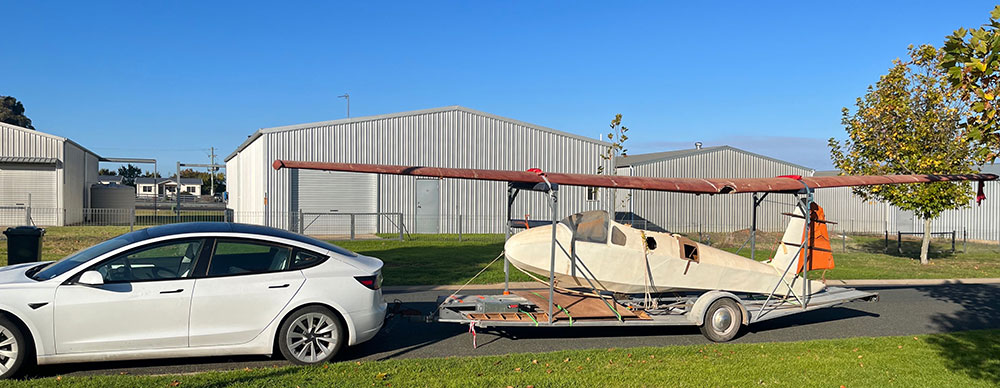
By Leigh Snell
In this article I’ll describe my experiences of using my electric vehicle to tow my glider, to help answer the question of whether or not an EV makes a practical gliding tow car. The simple answer is yes, but…
I have a Tesla Model 3 Long Range with a tow bar rated at 1,000kgs. Tesla claims, in practical terms, a range of about 550km from full charge to completely empty.
I live in the southeastern suburbs of Melbourne and I am a member of the Australian Gliding Museum at Bacchus Marsh, where I also fly. I usually charge my car at home overnight, and I’ve found that I can easily complete the return trip of just over 200kms in a single charge, with or without a trailer.
I have also visited the Bendigo Gliding Club, which is just over 400km return trip. I could just make it without a trailer, but charged up for about 5 or 10 minutes at the Bendigo Supercharging station on my way home. I then arrived at home with more than 20% (110kms) to spare.
Early in January, I travelled to Millicent for the Vintage Gliding Regatta without a trailer, a round trip of just under 1,100kms. A choice of routes is available but I chose to go via Ballarat and Mt. Gambier charging stations. We drove with a few scenic detours including a stop at the Sir Reginald Ansett Transport Museum in Hamilton. I would strongly recommend it as a worthwhile stop to anyone travelling through the area.
First Stop Millicent
We travelled to the hotel at Millicent, where they provided an outdoor power point. This was enough to charge the car to full overnight as we never did more 200kms each day, or just travelled a few kilometres and spent a few hours with the car parked and the air-conditioning on.
Prior to the trip, I emaiIed a number of hotels in Millicent asking them what facilities they had for charging. Only one replied. Most places assume electric cars can only be charged at special charging stations, and that an ordinary powerpoint is of no use, which is wrong, of course. On checking-out, the operators relied on my honesty to tell them how much power I had used and to pay for it.
Nymph in Tow
The next gliding-related trip was to pick up a Nymph II from Temora that had been donated to the Gliding Museum. The trailer to be used was at the Bendigo Gliding Club. I travelled from home to the Bendigo Supercharging station and then on to Bendigo Gliding Club to get the open trailer. Initially, the car wanted to stop at Wodonga for charging but soon realised that it was towing a load and decided it wanted stop at Shepparton, then Wodonga and finally at Temora.
Many charging stations are not designed for charging a car while towing a trailer. In some cases you can remain hitched, but in others you need to find somewhere to leave the trailer while charging. In NSW, the NRMA have free charging stations so I able to save over $20 in charging fees.
Auto Pilot
The following day we loaded the glider onto the open trailer and tied it down, ready for an early start to head back to Bacchus Marsh the next day. It was recommended to me to avoid exceeding 80kph with a fully loaded open trailer, so I set the auto pilot to 80kph for the remainder of the trip. The car did a good job driving with a trailer and I only took over when we approached the townships or the outer suburbs of Melbourne. Being passed by trucks was not an issue as I barely noticed them.
With the glider on the open trailer, the car wanted to top up at Wagga Wagga, Wodonga, Euroa and then Bacchus Marsh. At Euroa, one of the charging stalls was set up for trailers but was barely adequate for a trailer with a 13m wing on top. I was able to drive in and charge up, but then needed assistance to reverse out, as there wasn’t enough space to turn around.
After dropping off the trailer at Bacchus Marsh, I had a little over 20% charge remaining and no charging stations in the town, so on my way out I stopped a few kilometres away at Melton for a free top up charge.
Calculations
The total trip was 1,440kms, costing $118.40 in charging costs, although some free charging opportunities arose, as noted above. Over the three days, the car used 160Wh/km (Watt hours per kilometre) without a trailer, 230Wh/km with a trailer, and 260Wh/km with a trailer and glider, which proves that drag is more significant than weight. I suspect that a blunt nose on an enclosed trailer is likely to result in higher power consumption but have yet to test this.
I needed to use the following apps on my phone – Tesla, ABRP (A Better Route Planner) and Plug Share. The car was Internet connected, so in most cases it was able to tell me ahead of time if the charging stations were working and available. Most stops took about 15 minutes to charge, so I broke each day into morning tea, lunch and then afternoon tea, giving myself ample rest stops.
As a conclusion, I would recommend that an electric car does work as a gliding tow car, but requires a little planning.
































